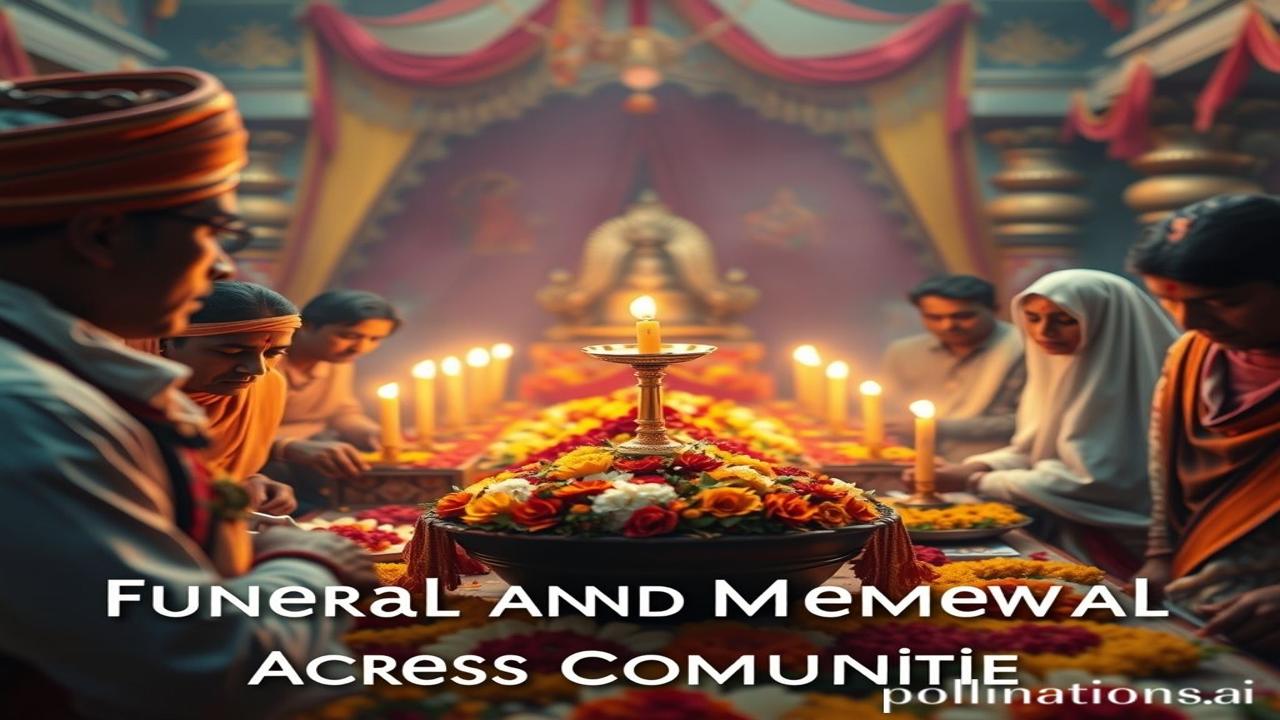Waqt Ki Awaaz: Funeral Aur Memorial Traditions – Ek Khoj (A Search)
Kabhi kabhi sochta hoon, jab koi humein chhod ke jaata hai, toh kya le jaata hai? Sirf jism toh yahin reh jaata hai, mitti mein mil jaata hai. Par unki yaadein, unka pyaar, unka influence… woh sab toh humare dil mein, humare jeevan mein hamesha zinda rehta hai. Aaiye, aaj hum Bharat ki dharohar mein chhupi funeral aur memorial traditions ki khoj mein nikalte hain. Ye sirf rasmein nahi hain, ye humare jazbaaton ka, humari sanskriti ka ek aaina hain.
Itihas Ki Gehraiyon Mein: Funeral Aur Memorial Traditions Kya Hai?
Funeral (antim sanskar) aur memorial traditions kisi ki death ke baad unko samman dene, unki aatma ki shanti ke liye kiye jaane wale rituals aur ceremonies hain. Yeh traditions duniya bhar mein different communities mein alag-alag tareekon se manaye jaate hain. India mein, iska itihas bahut purana hai. Ancient texts jaise Vedas aur Upanishads mein bhi iska zikr milta hai.
Kab Aur Kahan? In traditions ki roots Indus Valley Civilization (3300-1700 BCE) tak jaati hain. Archaeological evidence se pata chalta hai ki us zamane mein bhi log apne dead ko carefully bury karte the, saath mein belongings rakhte the, jo after-life mein unke belief ko darshata hai. Fir Vedic period aaya, jisme cremation (dah sanskar) ko importance mili.
Importance Kya Hai? Funeral aur memorial traditions sirf death se deal karne ka tareeka nahi hai, yeh humare belief system, values aur community ke bond ko bhi reflect karte hain. Yeh families ko loss se cope karne mein help karte hain, deceased ko remember karne ka ek platform dete hain, aur aane wali generation ko culture aur values transfer karne mein important role play karte hain.
Zameeni Sach: Logo Aur Jeevan
Imagine a village in Rajasthan, 500 years ago. Raat ka sannata hai. Ek ghar mein roshni jal rahi hai. Ma Babita, jo gaon ki sabse buzurg mahila hain, ab nahi rahin. Unki potiyan unke paas baithi hain, unke mathe ko sehlati hui. Gaon ke log ikattha ho rahe hain.
“Beta, Ma Babita ne humein bahut kuch sikhaya,” Panditji ne kaha. “Unki aatma ki shanti ke liye humein Vedon ka path karna hoga.”
Agle din, Babita ji ka jism safed kapde mein lapeta jaata hai, aur ek chita banai jaati hai. Pure gaon ke log shamil hote hain. Chita mein aag lagai jaati hai, aur mantras gunjte hain.
“Aatma amar hai,” Panditji ne kaha. “Yeh sirf ek naya safar shuru kar rahi hai.”
Is tarah, gaon walon ne Babita ji ko samman ke saath vida kiya. Unki yaadein, unki kahaniyaan, har ghar mein sunayi jaati rahengi. Unki sikhai hui baatein, unki values, aane wali generation ko inspire karti rahengi.
Dharohar Aur Pehchaan: Aaj Ke Bharat Mein
Aaj bhi, funeral aur memorial traditions India mein bahut important hain. Hinduism, Islam, Sikhism, Christianity, aur Buddhism, har religion mein apne-apne unique rituals hain.
- Hinduism: Cremation is common, followed by ash immersion in holy rivers like Ganga. Shradh is performed to honor ancestors.
- Islam: Burial is the norm. Prayers are offered for the deceased.
- Sikhism: Cremation or burial can be practiced. Readings from the Guru Granth Sahib are common.
- Christianity: Burial is typical. Prayer services and memorial gatherings are held.
- Buddhism: Cremation or burial, with emphasis on mindful ceremonies and teachings.
In traditions ki wajah se hi aaj hum apni roots se jude hue hain. Yeh traditions humein yaad dilati hain ki hum sabhi insaan hain, aur hum sabhi ek din is duniya ko chhod ke jaayenge. Lekin humari yaadein, humare kaam, humari values, hamesha zinda rahenge. Yeh Bharatiyata ka, Indianness ka, ek important part hai.
Majedar Tathya Ya Bhram-Bhanjak:
Myth: Log samajhte hain ki funeral sirf dukhi hone ka waqt hai.
Truth: Funeral sirf dukhi hone ka nahi, balki celebrate karne ka bhi waqt hai – celebrate karne ka uss jeevan ko jo jiya gaya, uss impact ko jo kisi ne create kiya, uss pyaar ko jo kisi ne spread kiya.
Fun Fact: Varanasi, known as Kashi, is considered one of the holiest places for Hindus to die. It’s believed that dying in Kashi grants liberation from the cycle of rebirth.
Drishya Aur Bhavnaen:
Imagine the Ganga ghats in Varanasi at dawn. The air smells of incense and marigolds. The sound of chanting echoes across the water. The feel of the ancient stones under your feet. The sight of countless diyas floating on the river, each representing a life that once was. This is a sensory experience that connects you to the cycle of life and death, a reminder of our shared humanity.
Antim Vichar Ya Uddharan:
“Mrityu satya hai, jeevan ek sapna. Par pyaar, karuna, aur sewa, yeh hamesha amar rahenge.”
- “मृत्यु सत्य है, जीवन एक सपना | पर प्रेम, करुणा, और सेवा, यह हमेशा अमर रहेंगे ||”
So, let us remember those who have left us, not just with tears, but with gratitude and love. Let us honor their memory by living a life that is meaningful, compassionate, and full of purpose. Let us carry their values forward, and keep their stories alive for generations to come. This is the true essence of our funeral and memorial traditions.
“`
“`
